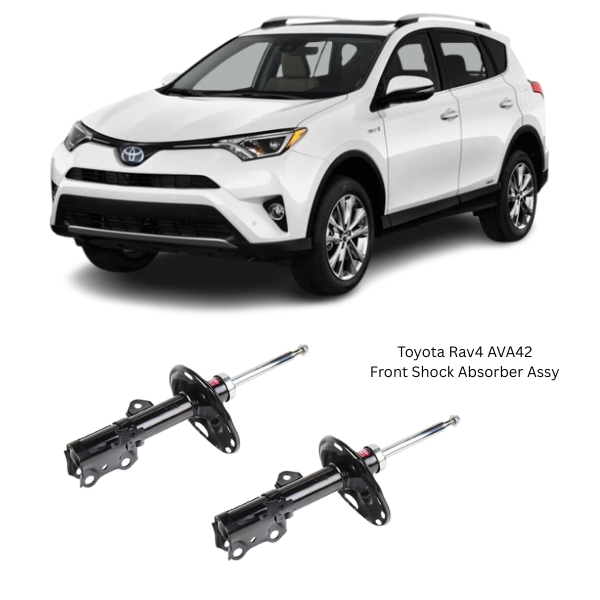Get Toyota Rav4 AVA42 Front Shock Absorber Assy 3350039 in Kenya
The Front Shock Absorber Assembly is a critical suspension component designed to control the movement of the vehicle’s front wheels and maintain tire contact with the road surface. It plays an essential role in providing comfort, handling stability, and safety by managing the energy generated by suspension movement over various terrains.
1. Function and Importance
When a vehicle drives over bumps, potholes, or uneven surfaces, the suspension springs compress and release to absorb the impact. Without proper damping, these springs would continue to bounce, making the ride uncomfortable and unsafe.
The front shock absorber assembly works by converting kinetic energy from suspension movement into heat energy, which is dissipated through hydraulic fluid. This process reduces excessive bouncing, stabilizes the vehicle, and ensures that the tires remain firmly in contact with the road — crucial for steering control, braking efficiency, and overall vehicle stability.
2. Structure and Components
A typical front shock absorber assembly consists of several key parts:
-
Piston and Piston Rod: The piston moves up and down inside the cylinder, controlling hydraulic fluid flow. The rod connects the piston to the vehicle’s suspension.
-
Cylinder (Tube): Contains the hydraulic fluid and houses the piston mechanism.
-
Hydraulic Fluid: Special oil that resists foaming and maintains damping efficiency under various temperatures.
-
Valves: Control the rate of fluid flow to regulate damping force for compression and rebound strokes.
-
Mounting Bushings: Rubber or polyurethane components that reduce vibration and noise while securing the assembly to the chassis and suspension.
-
Protective Dust Boot: Prevents dirt, moisture, and debris from damaging the piston rod and seals.
3. Types of Shock Absorber Designs
While the basic function is the same, front shock absorbers come in different designs:
-
Twin-Tube Design:
-
Inner working tube and outer reserve tube.
-
Cost-effective, widely used, and provides a smooth ride.
-
-
Monotube Design:
-
Single tube housing both piston and gas chamber.
-
Offers better heat dissipation and performance in demanding conditions.
-
-
Gas-Charged Shocks:
-
Nitrogen gas pressurization reduces oil foaming.
-
Improves responsiveness and stability.
-
4. Performance Characteristics
A high-quality front shock absorber assembly delivers:
-
Consistent Damping: Maintains stability during acceleration, braking, and cornering.
-
Improved Ride Comfort: Smooths out bumps and vibrations.
-
Enhanced Handling: Reduces body roll, nose dive, and squat during various driving maneuvers.
-
Better Tire Contact: Ensures even tire wear and optimal grip.
-
Durability: Withstands harsh conditions, heat, and repeated impacts without performance loss.
5. The Role in Vehicle Safety
The front shock absorber assembly directly impacts critical safety aspects:
-
Braking Efficiency: Keeps tires firmly on the road, reducing stopping distance.
-
Steering Control: Improves stability during turns and sudden maneuvers.
-
Traction: Ensures maximum tire-to-road contact in all conditions.
A worn or damaged shock absorber can significantly reduce these safety benefits.
6. Service Life and Replacement Intervals
The lifespan of a front shock absorber assembly varies based on driving conditions, load, and maintenance:
-
Normal road use: 60,000–100,000 km.
-
Rough or off-road driving: May require replacement as early as 40,000 km.
-
Heavy loads or towing: Increased wear due to greater suspension stress.
7. Signs of a Worn or Failing Front Shock Absorber
Drivers should watch for these symptoms:
-
Excessive bouncing after hitting a bump.
-
Nose diving during braking.
-
Uneven or rapid tire wear.
-
Fluid leaks around the shock body.
-
Steering instability or drifting.
-
Clunking or knocking sounds over rough roads.
8. Installation and Maintenance
Replacing a front shock absorber assembly requires proper mechanical knowledge:
-
Lift and Secure Vehicle: Use jack stands to ensure stability.
-
Remove Wheel: Access the suspension components.
-
Disconnect Mounts: Detach the shock absorber from both the suspension and chassis.
-
Install New Assembly: Align mounting points, torque bolts to manufacturer specifications.
-
Inspect Related Components: Check springs, mounts, and bushings for wear.
-
Test Drive: Confirm stability and comfort after installation.
Routine inspections every 20,000 km can help detect early signs of wear.
9. Environmental and Driving Influences
Several factors can shorten the service life of a front shock absorber assembly:
-
Poor road conditions: Potholes, gravel, and uneven surfaces increase wear.
-
Climate: Extreme heat can degrade seals; cold can thicken hydraulic fluid.
-
Driving style: Aggressive driving puts more strain on the suspension.
-
Load weight: Heavier loads require greater damping force, increasing wear.
10. Quality Standards and Testing
Premium front shock absorber assemblies are tested for:
-
Damping Performance: Ensures stability across compression and rebound cycles.
-
Durability: Simulated road conditions to measure long-term resilience.
-
Corrosion Resistance: Coatings and treatments protect against rust.
-
Temperature Tolerance: Maintains performance in both hot and cold climates.
Compliance with ISO, SAE, or equivalent standards ensures reliable operation.
11. Advantages of a Quality Front Shock Absorber Assembly
-
Smoother and more comfortable ride quality.
-
Enhanced control in emergency maneuvers.
-
Longer tire lifespan due to reduced uneven wear.
-
Reduced stress on other suspension components.
-
Improved safety in wet or slippery conditions.
12. Proper Pair Replacement
For balanced handling and safety, front shock absorbers should always be replaced in pairs. Installing one new shock on one side can cause uneven damping, resulting in poor stability and unpredictable handling.
Follow us on Facebook for more parts.





Reviews
Clear filtersThere are no reviews yet.